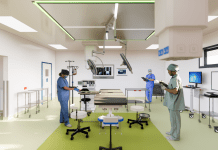Utilising modular construction and retrofitting industrial spaces could be key to driving the UK’s life sciences sector’s continued growth, argues Remi Smith
Responsible for a number of ground-breaking medical discoveries, the UK’s life sciences sector has seen a significant surge in investment over the past few years, especially in industrial spaces. With the government’s valuation of the sector sitting at £94bn, the growth of the life sciences sector has rapidly spread to investment hubs outside of the South East’s Golden Triangle.
The Liverpool City Region recently announced a significant rise in funding for its Life Sciences Investment Zone, now totalling £160m – a strategic enhancement that positions the North West as a vibrant hub for the sector’s continued growth.
Although investments are being funnelled into areas such as Liverpool’s Knowledge Quarter and Manchester Science Park, the supply of space is eclipsed by the soaring demand for laboratories due to increased investment. Coupled with the climbing costs of lease agreements, businesses are now uncovering the opportunity in alternative, flexible space.
A shift in demand for industrial spaces
The appeal of industrial space stretches beyond the logistics and manufacturing industries. Within the real estate sector, we’ve been witnessing a shift in demand for alternative spaces for some time, as businesses seek to remedy the absence of affordable and flexible commercial space.
In 2023, the real estate sector observed take up of a massive 22.3m square feet of industrial space, exemplifying the strategic shift from traditional commercial space, as both developers and occupiers begin to recognise the previously overlooked potential of mid-box units.
The life sciences sector, in particular, is switched on to the opportunities that industrial spaces present, with a growing number of occupiers and operators turning to retrofitted industrial units that offer the flexibility to scale and succeed. The elevated ceiling height of industrial units is becoming favoured among life sciences occupiers and operators, while the broader versatility of these units enables the ever-increasing move towards modular design.
Although retrofit projects require meticulous planning and a concerted strategy, the avoidance of significant embodied carbon costs, inherited from building new developments, only amplifies the appeal for the life sciences sector, as we continue to accelerate our efforts towards an environmentally and economically sustainable future.
Modular design as a catalyst for life sciences expansion
Fast-growing medtech businesses and funded R&D schemes are accelerating at pace, and therefore require versatile space that can be adapted to enable agile working and significant growth. When also considering the shift in occupier attitudes towards fostering collaboration and innovation in working environments, the increased traction for modular design is apparent.
As the life sciences sector evolves, the spaces they inhabit must follow. The art of modular design expels traditional partitioning, allowing companies to scale up or cut back their office, research and laboratory space depending on their growth trajectory. Enabling customisation and repurposing, modular design permits occupiers to shape and modify their spaces at a pace that complements their needs.
A modular approach to design also offers countless operational benefits. Occupiers can fit out a space that allows equipment to be easily removed and reinstalled at a new location. This is a great example of how these innovative and flexible spaces can offer significant cost savings to the occupier and landlord.
As occupiers look to the opportunity in industrial space, it’s imperative for advisory firms to push this value-add education to industrious landlords, underpinning a new phase of versatile, modular space that offers the opportunity to catalyse growth across the sector.
Expanding life sciences ecosystems
The interplay of increased life sciences investment and the considerable surge in the cost of lease agreements has incited a ripple effect, leading to a sharp rise in demand for industrial space across the sector. The life sciences sector is an example of how public and private sector collaboration has been pivotal to unlocking growth, with key voices across both parties realising opportunity and regenerating unconventional space to deliver and maximise value.
As investment continues to rise across the sector, it’s clear that city regions must look to the versatility of industrial units to remedy the lack of R&D and laboratory space, expanding life sciences ecosystems beyond their university hotspots and attracting further investment to unlock continued growth.














